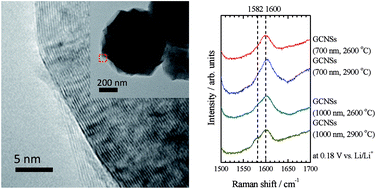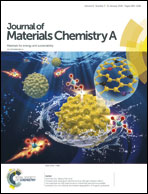Lithium-ion intercalation and deintercalation behaviors of graphitized carbon nanospheres†
Abstract
As negative electrode materials for lithium-ion batteries, graphitized carbon nanospheres (GCNSs) exhibit excellent capacity retention and high-rate capability. GCNSs with diameters less than 1 μm possess core–shell structures with a low graphitized core and an outer graphitized shell arranged in a concentric orientation. In the present work, the structural changes in GCNSs with various sizes and heat-treatment temperatures during lithium-ion intercalation and deintercalation were examined. Charge–discharge measurements and in situ Raman spectroscopy were used to investigate the origin of the specific electrochemical properties of GCNSs. The results indicated that GCNSs with small sizes and low heat-treatment temperatures did not exhibit the formation of stages 4 and 3 during lithium-ion intercalation and deintercalation. In addition, phase transition between different stage structures was ambiguous. This behavior was related to the disordered stacking structures of the outer graphene layers. In addition to the decreased size that increased the specific surface area and reduced the lithium-ion diffusion length within a particle, the high-rate capability of GCNSs can be ascribed to the monotonous and moderate structural changes. The excellent capacity retention can also be attributed to the specific structure of GCNSs.



 Please wait while we load your content...
Please wait while we load your content...